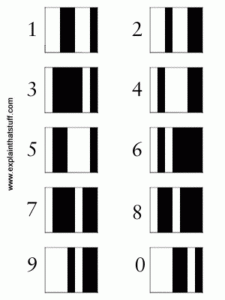
The letters in the word laser stand for Light Amplification by Stimulated Emission of Radiation. Lasers are very concentrated, narrow beams of light in which the laser’s light beams travel with their waves lined up. This is very different from regular light, like that from a flashlight, where the waves are all mixed up with the crests and troughs not lined up. The alignment of light waves in lasers allows the laser beam to be very focused and can concentrate a lot of energy in a very small area. Laser light does not occur in nature, rather it is produced – first invented in 1958.
Bar-code scanners are a pretty simple idea: use light to read numbers from a label. A universal produce code (UPC) bar-code is the most common product label that bar-code scanners read. UPC bar-codes gives each digit the exact same amount of space – 7 units – and the numbers are represented by various thickness of lines within those 7 units.

The concept of a bar-code scanner was first developed in the 1950s but required a 500 watt light-bulb (not very practical). It took the invention of the laser and it’s ability to have concentrated light to make bar-code scanners practically possible.
On June 24th, 1974 the first product was commercially scanned with a bar-code scanner: a pack of gum in a grocery store in Ohio. Bar-code scanning technology was adopted slowly at first. By 1978 only 1% of stores had bar-code scanners. By 1986 half of stores had bar-code scanners and by the early 1990s the technology was basically universally adopted. For you youngsters, how did the world operate if products didn’t have bar-codes? They had prices on them that were keyed in by cashiers. Quite inefficient in terms of checking out as well as inventory control.
Ok, now we get to the REALLY interesting facts about bar-code scanners. Professor Emek Basker at the University of Missouri has calculated the economic effects of bar-code scanners using UPC codes.
- Productivity at stores that adopted bar-code scanners prior to 1982 increased 4.5%. Over time productivity gains have increased as the technology has improved and the benefits of the technology expanded to also include sophisticated inventory management. These productivity increases mean HUGE savings for consumers and increased profitability for retailers.
- Productivity from bar-code scanners has not been evenly distributed. Big stores, such as Walmart, have benefited much more than smaller stores. From the book How We Got to Now: “There have always been inherent advantages to maintaining a large inventory of items in a store: the customer has more options to choose from, and items can be purchased in bulk from wholesalers for less money. But in the days before bar-codes and other forms of computerized inventory-management tools, the benefits of housing a vast inventory were largely offset by the cots of keeping track of everything. “
- Thus, the rise of bar-code scanners spurred the rise of the big-box stores that dominate retail shopping such as Walmart, Costco and Home Depot.
- In 2016 the average number of items carried in a grocery store in America was 38,900 according to the Food Marketing Institute. In the 1974 the amount of products per grocery store was around 9,000. Similar inventory increases were seen at other types of retailers.
- An example: in 1980 the average grocery store carried three different types of apples. Now the average grocery store carries 27 different apple SKUs. There are factors other than just bar-code technology that has led to the increase in SKUs at retailers, but bar-code technology is a big and possibly necessary factor.
- A side effect of bar-code scanners is the de-skilled nature of the cashier position.
Link to Dr. Basker’s Paper on bar-code scanners and productivity: http://www.nber.org/papers/w17825.pdf



0 Comments